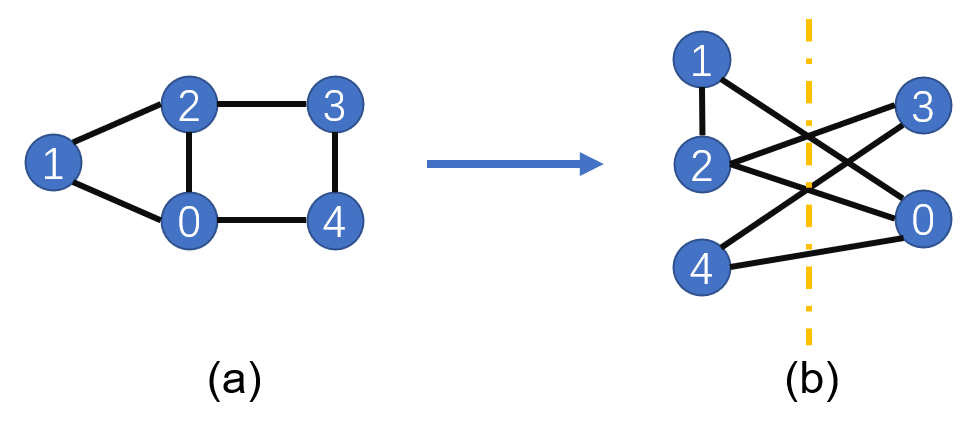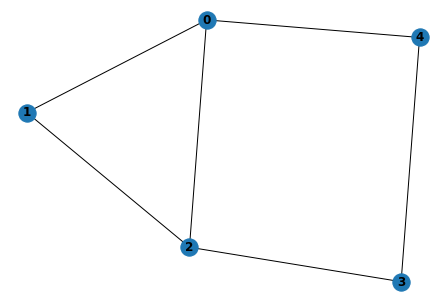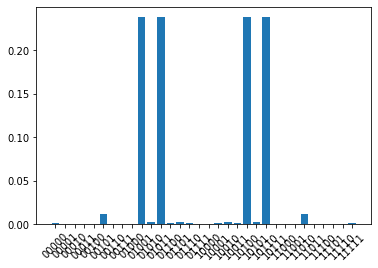Quantum Approximate Optimization Algorithm
Overview
Quantum approximate optimization algorithm (QAOA) is a quantum algorithm that uses quantum computers to solve combination optimization problems. It was first proposed by Farhi et al. in 2014. In this tutorial, we will use QAOA to solve the Max-Cut problem and get familiar with the construction and training of quantum circuits in MindQuantum.
This document applies to the CPU environment. You can obtain the complete executable sample code at https://gitee.com/mindspore/mindquantum/blob/r0.3/tutorials/source/quantum_approximate_optimization_algorithm.py.
Environment Preparation
This tutorial requires the following library:
networkx
NetworkXis a library for the creation, manipulation, and study of the structure, dynamics, and functions of complex networks. You can run thepip3 install networkxcommand to install it.
Max-Cut Problem Description
The Max-Cut problem is an NP-complete problem in the graph theory. It needs to divide vertices of a graph into two parts and make the most edges be cut. As shown in the following figure (a), a graph consists of five vertices, and the interconnected edges are (0, 1), (0, 2), (1, 2), (2, 3), (3, 4), and (0, 4). To maximize the number of edges to be cut, we divide 1, 2, and 4 into one group, and 0 and 3 into another group, as shown in the figure (b). Therefore, five edges are to be cut. When the number of vertices in a graph increases, it is difficult to find an effective typical algorithm to solve the Max-Cut problem. The following describes how to transform the Max-Cut problem into a Hamiltonian ground state capability solution problem.

Max-Cut Problem Quantization
Assign each vertex a quantum bit. If the vertex is allocated to the left side, its quantum bit is set to the \(\left|0\right>\) state. If the vertex is on the right side, its quantum bit is set to the \(\left|1\right>\) state. When two vertices are in different sets, the bits on the two vertices are in different quantum states. For the vertex 0 and the vertex 1, when their connection line is cut, quantum states corresponding to bits on the two vertices may be \(\left|\psi\right>=\left|0_11_0\right>\) or \(\left|\psi\right>=\left|1_10_0\right>\), where the subscript represents the vertex number. Select the Hamiltonian \(H=(Z_1Z_0-1)/2\), where \(Z\) is the Pauli \(Z\) operator. You can find that:
When vertices are in the same set, you can verify that:
Therefore, we only need to write the Hamiltonian \(H\) corresponding to the graph according to the preceding rule, and obtain the ground state energy and the ground state of \(H\) by using a quantum computer. Then, we can obtain the Max-Cut cutting solution and the maximum number of cut edges of the graph. Assuming that the set of all edges is \(C\) and the number of all edges is \(c\), the Hamiltonian can be written as follows:
Importing Dependencies
from mindquantum.circuit import Circuit,StateEvolution
from mindquantum import Hamiltonian, UN
from mindquantum.gate import H, ZZ, RX
from mindquantum.nn import MindQuantumAnsatzOnlyLayer
from mindquantum.ops import QubitOperator
import networkx as nx
import mindspore.nn as nn
import numpy as np
import matplotlib.pyplot as plt
Building a Graph to Be Solved
Use add_path to add edges to a graph. Then, the graph structure is drawn.
g = nx.Graph()
nx.add_path(g, [0,1])
nx.add_path(g, [1,2])
nx.add_path(g, [2,3])
nx.add_path(g, [3,4])
nx.add_path(g, [0,4])
nx.add_path(g, [0,2])
nx.draw(g,with_labels=True, font_weight='bold')

As shown in the preceding figure, a graph structure consisting of five vertices and six edges is obtained.
Setting up a QAOA Circuit
Circuit Setup
We use the quantum adiabatic approximation algorithm to evolve the quantum state from the eigenstate of \(X^{\otimes n}\) to the ground state of Hamiltonian corresponding to the graph.
Build the time-dependent evolution circuit of Hamiltonian corresponding to the graph:
def build_hc(g,para):
hc = Circuit()
for i in g.edges:
hc += ZZ(para).on(i)
return hc
Build the time-dependent quantum circuit for \(X^{\otimes n}\):
def build_hb(g, para):
hc = Circuit()
for i in g.nodes:
hc += RX(para).on(i)
return hc
To ensure that the final optimization result is accurate, the quantum circuit needs to be repeated for multiple times. Therefore, a multi-layer training network is built by using the following functions:
def build_ansatz(g, p):
c = Circuit()
for i in range(p):
c += build_hc(g,f'g{i}')
c += build_hb(g,f'b{i}')
return c
Build Hamiltonian corresponding to the graph:
def build_ham(g):
hc = QubitOperator()
for i in g.edges:
hc += QubitOperator(f'Z{i[0]} Z{i[1]}')
return hc
Generating a Complete Quantum Circuit and the Hamiltonian Corresponding to the Graph
In this example, p = 4 is selected, indicating that the four-layer QAOA quantum circuit is used. ansatz is a quantum circuit for solving the problem, and init_state_circ is a quantum circuit for preparing a quantum state on a uniformly superposed state.
p = 4
ham = Hamiltonian(build_ham(g))
ansatz = build_ansatz(g, p)
init_state_circ = UN(H, g.nodes)
Building a Quantum Neural Network to Be Trained
This problem does not require a coding-layer quantum circuit, so we use MindQuantumAnsatzOnlyLayer as a quantum neural network to be trained and an Adam optimizer.
net = MindQuantumAnsatzOnlyLayer(ansatz.para_name, init_state_circ+ansatz, ham)
opti = nn.Adam(net.trainable_params(), learning_rate=0.05)
train_net = nn.TrainOneStepCell(net, opti)
Displaying Training Results
for i in range(600):
if i%10 == 0:
print("train step:", i, ", cut:", (len(g.edges)-train_net())/2)
train step: 0 , cut: [[3.0059216]]
train step: 10 , cut: [[3.3262742]]
train step: 20 , cut: [[3.7228582]]
train step: 30 , cut: [[3.983411]]
train step: 40 , cut: [[4.135832]]
train step: 50 , cut: [[4.216693]]
train step: 60 , cut: [[4.2141833]]
train step: 70 , cut: [[4.2036085]]
train step: 80 , cut: [[4.260594]]
train step: 90 , cut: [[4.373112]]
train step: 100 , cut: [[4.4853263]]
train step: 110 , cut: [[4.5553446]]
train step: 120 , cut: [[4.587566]]
train step: 130 , cut: [[4.611128]]
train step: 140 , cut: [[4.637698]]
train step: 150 , cut: [[4.6584387]]
train step: 160 , cut: [[4.66508]]
train step: 170 , cut: [[4.663408]]
train step: 180 , cut: [[4.6678705]]
train step: 190 , cut: [[4.6875486]]
train step: 200 , cut: [[4.7206187]]
train step: 210 , cut: [[4.7580614]]
train step: 220 , cut: [[4.7893686]]
train step: 230 , cut: [[4.8074245]]
train step: 240 , cut: [[4.8116426]]
train step: 250 , cut: [[4.8077316]]
train step: 260 , cut: [[4.803544]]
train step: 270 , cut: [[4.8039436]]
train step: 280 , cut: [[4.8088512]]
train step: 290 , cut: [[4.8154163]]
train step: 300 , cut: [[4.821649]]
train step: 310 , cut: [[4.8281393]]
train step: 320 , cut: [[4.8366113]]
train step: 330 , cut: [[4.847317]]
train step: 340 , cut: [[4.858108]]
train step: 350 , cut: [[4.865946]]
train step: 360 , cut: [[4.8693476]]
train step: 370 , cut: [[4.869488]]
train step: 380 , cut: [[4.868954]]
train step: 390 , cut: [[4.8695197]]
train step: 400 , cut: [[4.8711824]]
train step: 410 , cut: [[4.8730283]]
train step: 420 , cut: [[4.874686]]
train step: 430 , cut: [[4.8768916]]
train step: 440 , cut: [[4.880748]]
train step: 450 , cut: [[4.8865013]]
train step: 460 , cut: [[4.8930907]]
train step: 470 , cut: [[4.898922]]
train step: 480 , cut: [[4.9031305]]
train step: 490 , cut: [[4.906122]]
train step: 500 , cut: [[4.9088955]]
train step: 510 , cut: [[4.9119415]]
train step: 520 , cut: [[4.9149566]]
train step: 530 , cut: [[4.9175825]]
train step: 540 , cut: [[4.920064]]
train step: 550 , cut: [[4.9228735]]
train step: 560 , cut: [[4.925872]]
train step: 570 , cut: [[4.9282985]]
train step: 580 , cut: [[4.929679]]
train step: 590 , cut: [[4.930426]]
Based on the above training results, we find that the number of cut edges corresponding to the ground state energy of Hamiltonian is close to 5.
Displaying Quantum State
We have obtained the optimal values of the parameters in the quantum circuit through training. Next, we use the final_state of the StateEvolution class to output the quantum state of the quantum circuit in the case of optimal parameters. The ket parameter indicates whether to represent the final quantum state as the right vector.
pr = dict(zip(ansatz.para_name, net.weight.asnumpy()))
print(StateEvolution(init_state_circ+ansatz).final_state(pr, ket=True))
(0.017737679183483124-0.03180303797125816j)¦00000⟩
(-0.02683155983686447+0.0012889178469777107j)¦00001⟩
(0.011993971653282642+0.006973826792091131j)¦00010⟩
(-0.014608755707740784-0.003942559473216534j)¦00011⟩
(-0.02683155983686447+0.0012889178469777107j)¦00100⟩
(0.00725862430408597+0.10942266136407852j)¦00101⟩
(-0.014608755707740784-0.003942559473216534j)¦00110⟩
(0.008969870395958424-0.004171415697783232j)¦00111⟩
(0.00950924027711153-0.00026544960564933717j)¦01000⟩
(-0.37196943163871765-0.3156493902206421j)¦01001⟩
(-0.040885526686906815+0.037214867770671844j)¦01010⟩
(-0.37196943163871765-0.3156493902206421j)¦01011⟩
(-0.03160367161035538+0.009305878542363644j)¦01100⟩
(-0.040885526686906815+0.037214867770671844j)¦01101⟩
(-0.03160367161035538+0.009305878542363644j)¦01110⟩
(0.00950924027711153-0.00026544960564933717j)¦01111⟩
(0.00950924027711153-0.00026544960564933717j)¦10000⟩
(-0.03160367161035538+0.009305878542363644j)¦10001⟩
(-0.040885526686906815+0.037214867770671844j)¦10010⟩
(-0.03160367161035538+0.009305878542363644j)¦10011⟩
(-0.37196943163871765-0.3156493902206421j)¦10100⟩
(-0.040885526686906815+0.037214867770671844j)¦10101⟩
(-0.37196943163871765-0.3156493902206421j)¦10110⟩
(0.00950924027711153-0.00026544960564933717j)¦10111⟩
(0.008969870395958424-0.004171415697783232j)¦11000⟩
(-0.014608755707740784-0.003942559473216534j)¦11001⟩
(0.00725862430408597+0.10942266136407852j)¦11010⟩
(-0.02683155983686447+0.0012889178469777107j)¦11011⟩
(-0.014608755707740784-0.003942559473216534j)¦11100⟩
(0.011993971653282642+0.006973826792091131j)¦11101⟩
(-0.02683155983686447+0.0012889178469777107j)¦11110⟩
(0.017737679183483124-0.03180303797125816j)¦11111⟩
Probabilistic Graph
We draw the probability distribution of the final quantum state under the calculated basis vector.
def show_amp(state):
amp = np.abs(state)**2
n_qubits = int(np.log2(len(amp)))
labels = [bin(i)[2:].zfill(n_qubits) for i in range(len(amp))]
plt.bar(labels, amp)
plt.xticks(rotation=45)
plt.show()
state = StateEvolution(init_state_circ+ansatz).final_state(pr)
show_amp(state)

According to the probability distribution diagram, the Max-Cut problem has four degenerate solutions, and the probability corresponding to each solution is about 25%.
Summary
We use the quantum approximation optimization algorithm to solve the Max-Cut problem and obtain the Max-Cut solution corresponding to the graph in the case.
References
[1] Edward Farhi, Jeffrey Goldstone, and Sam Gutmann. A Quantum Approximate Optimization Algorithm
